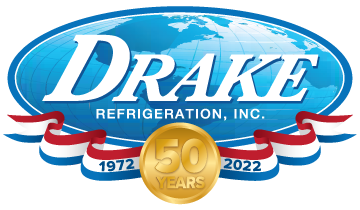
Air-cooled and water-cooled industrial-grade chillers are critical for industrial processes, such as plastics, pharmaceuticals, commercial printing, and transportation manufacturing. Our clients also rely on them for brewing processes, dairy farm operations, and medical equipment processing. Both air-cooled and water-cooled chillers work by removing the heat from your processes so that your equipment stays cool, so they can keep running strong. In this post, we’re providing an insider look at the main components of a process chiller and the importance of each one.
If you’ve ever wondered what’s inside a chiller, here are the four main components of both air-cooled and water-cooled process chillers to know about:
- Evaporator
- Compressor
- Condenser
- Expansion valve
Keep reading to learn more about each essential part and how it contributes to the industrial cooling process. We’ve also included a pro tip for each component to help you become savvy in the various chiller options.
Evaporator
What it is: The three primary types of evaporators for evaporators are coil, shell and tube, and brazed plate. Coil evaporators are the ones you see in many home air-conditioning units where warm air passes over a coil with refrigerant, causing liquid to form and run off into a pan that drains away. Shell and tube evaporators work by transferring heat between two fluids, one running through the tubes and the other flowing over the tubes and through the shell. Plate evaporators, like the brazed pate ones we use, feature rising and falling plates that thin liquid films pass over to initiate the evaporation process.
What it does: The essential role of the evaporator is to absorb heat. At the start of the cooling phase, the water or glycol mixture from your processes enters the evaporator. After it arrives, the process heat boils the refrigerant fluid, which converts it from a low-pressure liquid to a low-pressure gas.
Pro tip: If you have temperature requirements, look for chillers that have low-temperature options. For instance, during our engineering process, we size all evaporators and heat exchangers for specific fluids based on your application.
Compressor
What it is: Vapor-compression chillers are available in a few different types, including scroll, screw, and semi-hermetic compression. Chiller compressors are also available in a range of power. For instance, our industrial chillers have compressors with power as low as 1/4 hp and as high as 214 hp, depending on the application.
What it does: The compressor inside a chiller works to compress the low-pressure gas, or vapor, from the evaporator and convert into a high-pressure gas.
Pro tip: When determining the best compressor for your chiller, consider whether you’ll need full or partial redundancy. That will inform whether a single-circuit, dual-circuit, or dual-circuit tandem arrangement will give you the best performance.
Condenser
What it is: Located between the compressor and expansion valve, condensers are available in both air- and water-cooled units and can be configured in a split arrangement. When determining which condenser is best for your needs, consider your budget, energy efficiency, space, noise, and other environmental factors. Check out our article on the differences between air- and water-cooled chillers to learn more about the benefits and considerations of each option.
What it does: Chiller condensers are a specialized heat exchanger that uses either water or air to cool and condense the hot, high-pressure gas from the compressor down to a liquid.
Pro tip: If your industrial process is in a corrosive environment, has limited space, or has poor ventilation and heat issues, check out remote condenser systems. This option allows you to place the condenser and compressor in separate areas.
Expansion Valve
What it is: The most common types of expansion valves are thermal expansion valves, thermostatic expansion valves, and the electronic expansion valve. While they all function the same, they all work a little differently. Ask a chiller expert about which valve is best for your application.
What it does: An expansion valve, or expansion device, controls the amount of refrigerant that passes between the condenser and evaporator. It works to vary the flow based on the change in the cooling load.
Pro tip: For low-temperature requirements, ask about electronic expansion valves (EEVs) to give you tight superheat control. They work by using a stepper motor that precisely regulates the valve’s position.
Each of these components of industrial-grade process chillers serves a vital role in cooling your equipment. To learn more about how chillers work, check out the article on our blog. If you’re interested in a Drake chiller, request a quote online, email us, or call (888) 289-7299 today.

